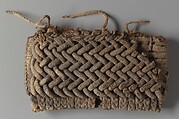Cache-Sexe
Not on view
This carefully crafted object is part of a rare group of female "modesty skirts," which are thought to have been worn low on the hips and held in place with a fiber cord. Commonly called a "cache-sexe," these fiber skirts are the oldest of their type to have survived the tropical climate of West Africa. The remarkable state of preservation of this example is due to the favorable climatic conditions of the cave in which it was found. Located within the Bandiagara Escarpment of present-day Mali, these caves are historically significant as the home of the ancient Tellem people, to whom this object is attributed, and later the Dogon. The Tellem are believed to have arrived at the Bandiagara Escarpment some time during the eleventh century and remained there until their population was devastated in the fifteenth to sixteenth centuries.
This cache-sexe consists of three interconnected layers and is constructed from a sophisticated combination of plating and twining techniques. These fabrication methods are closely related to techniques that were used to construct nets, snares, and baskets. Researchers believe that the cordage used to create this garment comes from the inner bark of the baobab tree.
Locally developed rather than imported, ancient garments like this one sharply contradict the myth that clothing was first introduced to sub-Saharan Africa through the expansion of Islamic trade. Although today, fiber cache-sexes have almost entirely disappeared, traditions using similar techniques survived in West Africa into the twentieth century. The similar quality of fiber and technique of more recent examples suggest that this form of clothing was once widely distributed in West Africa.
This image cannot be enlarged, viewed at full screen, or downloaded.

